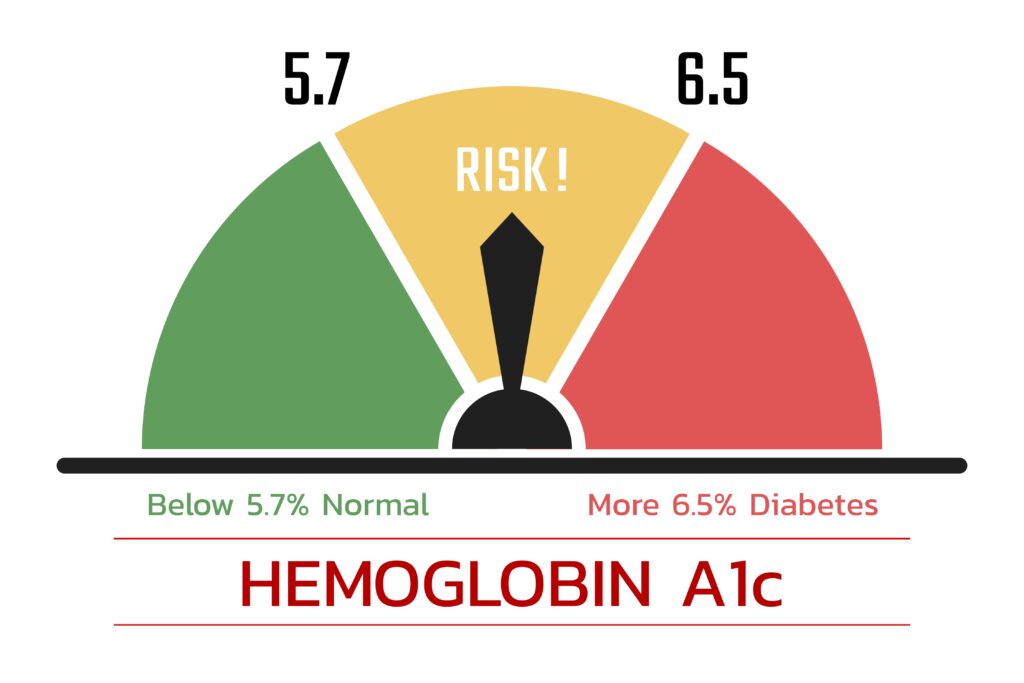
What is pre-diabetes?
You may have heard the term thrown around before and perhaps aren’t too sure what it may really mean.
Pre-diabetes can defined with an hemoglobin A1C test, a fasted plasma blood glucose test, or a glucose tolerance test. Pre-diabetes is considered an A1C measurement of 5.7-6.4 or a fasted blood glucose test of 100-125 mg/dl. A1C is a measurement of the amount of glucose (sugar) in your blood over a 2-3 month period. Pre-diabetes is a range that is above normal, but not quite in range for diagnosis of Type II Diabetes.

There are millions of adults that have pre-diabetes. More than 8 in 10 people have pre-diabetes and don’t even know that they do. It is a huge health concern.
Pre-diabetes is more common than you think. The good news is…this can be reversible! For everyone, this can be reversible by making diet and lifestyle changes.
Pre-diabetes puts you at increased risk for developing Type II diabetes, heart disease, kidney disease, stroke, and other metabolic conditions. This classification is so important in order to have the chance to make changes so that we don’t develop these conditions. By the time we are at a range to consider us to be diabetic, our pancreas has already been working overtime for years and years. It is not necessarily when something begins to go wrong. This is really important to understand.
If we never know that we fall into this category, it puts us at a stark disadvantage to change what the outcome may look like in a year, two years, etc.
Up to 70% of individuals who are pre-diabetic, eventually develop diabetes. 70%…that is wild. That does not need to be the case.
What are symptoms of pre-diabetes?
- Fatigue
- Increased urination
- Increased thirst
- Increased hunger
- Numbness and tingling and hands/feet
- Frequent infection
- Blurred vision
So, what’s going on with our bodies here?
We are having an issue with the way our bodies are processing sugar. Our pancreas secretes insulin when we eat food. The insulin takes the food, in the form of glucose (sugar), from the bloodstream into our cells to use as energy. If there is any disruption in this checks and balance system, we can run into problems long term. If there isn’t enough insulin produced, or if the insulin has become resistant to our cells, sugar will begin to build up in our blood stream. This is when we see a higher A1C and blood glucose test at the doctors office.
Pre-diabetes for Type II Diabetes is a state of insulin resistance. The insulin in our bodies is no longer able to efficiently push glucose into our cells. This is due to high levels of circulating insulin in our bodies. Our bodies have no become resistant to it.
Pre-diabetes is an indicator that you currently have metabolic dysfunction.
Causes
There can be many factors.
Here are just a few big ones…
- Body fat
- Sleep
- Chronic stress
- Medications
- Genetics
- Lack of physical activity
- Diet
There’s not one sole cause, but rather a handful of contributing causes. Again, the good news is we have the capability to influence A LOT of it.
Let me say that again, we are able to influence A LOT. We have that power.
Here’s what you can do:
First and foremost, get you blood work done!
Know what your fasting glucose or A1C levels are. Preferably your A1C, especially if you are having symptoms or have risk factors (i.e. long term obesity). Ask your doctor. Get a test done that is up to date and know your numbers. Knowledge is power here. Especially if your numbers fall near to the pre diabetes zone. This is an instance where your doctor may not even bring that up because you technically are not in an abnormal zone. Let’s be proactive here and an advocate for ourselves when it comes to our health.
Eat a metabolically healthy diet…limit processed foods and refined carbs like bread. Eat more veggies. Limit your sugar intake. Limit alcohol consumption.
Move more. MOVE MORE! Start small if needed and begin walking. The best movement is walking. We can incorporate walking multiple times throughout our day. Next, try body weight exercises at home. Muscle is your friend. Especially when it comes to diabetes in order to regulate insulin and blood sugar. The most important thing is to start somewhere.
Get quality sleep. Poor sleep can impair glucose processing and affect insulin resistance. Sleep influences cortisol, our stress hormone. Cortisol is known to up regulate insulin resistance. Sleep can also regulate appetite. It is so important to begin establishing a healthy sleep routine and planning your night to have approximately 8 hours of quality sleep.
Master your stress. Stress also stimulates cortisol and can stimulate the liver to release glucose. This is our fight or flight response in its glory. When we are stressed, our brains perceive a threat. We release sugar in order to RUN. This is physiological and psychological. This can leave us insulin resistance. Practices like deep breathing, walking, and establishing a support system can be extremely helpful.
In summary
Pre-diabetes is when your blood sugar is higher than normal, but not quite high enough to be considered diabetes. It is a really, really big deal.
1 in 3 adults have pre-diabetes. SO many don’t know it.
Pre-diabetes is an opportunity for us to take charge in our health. It is quite literally setting the stage for what is to come unless we make changes. We know at this stage something is already metabolically inefficient. We can do something about it so that we don’t develop diabetes, heart disease and other chronic diseases.
What will you do today to better your health?
Marissa is a licensed Occupational Therapist, certified personal trainer, and weight loss specialist living in Baltimore, MD.


